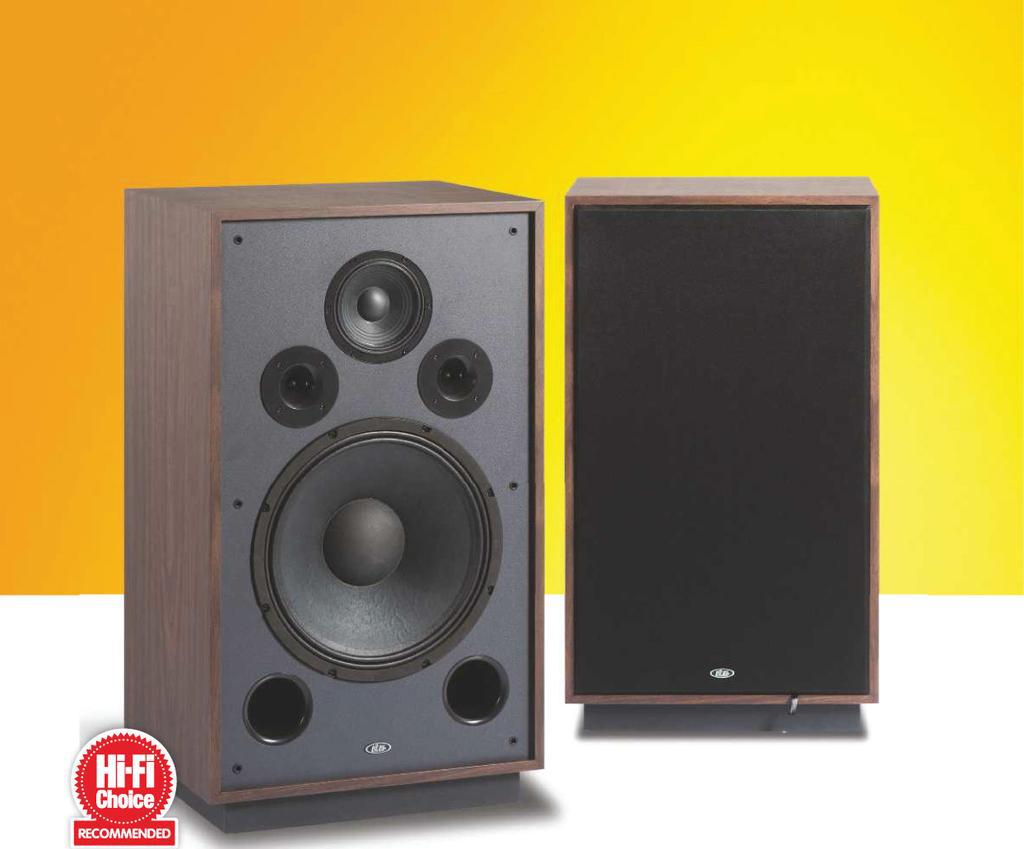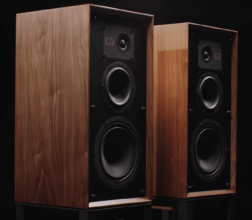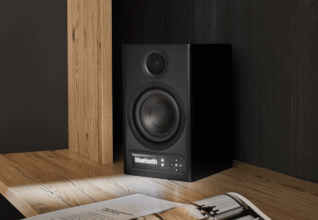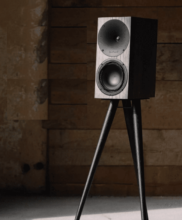Eltax Vintage PWR 1959 Review
Just like before, it’s yesterday once more. The wisdom of The Carpenters. Except, of course, little is quite as it seems. True survivors from the past like the LS3/5a standmount speaker – still being made to the original Seventies BBC recipe – are rare. New designs that evoke the spirit of old ones are increasingly not. Whether it’s turntables, amplifiers or loudspeakers, the yestergear wannabees may successfully conjure a vintage vibe, they might even attempt to avoid sounding modern but, more often than not, up-to-date components and engineering are used to create a kind of chronological hybrid: tasty old-school theme meets daisy-fresh tech in a glorious mash-up intended to add a psychological dimension to the business of nourishing the soul with super sound tied to a ‘safe’, broadly acceptable aesthetic.

In loudspeaker land, the nostalgia kick seems to be gathering pace. JBL, Dynaudio, Klipsch and Wharfedale are just some of the bigger names turning back the clock and the one thing they all appear to have in common is the idea that recreating or reimagining history doesn’t come cheap. Instead of an over-Sixties allowance, there’s a kind of old-timer premium and I suppose that figures. Or it does until you clap eyes – preferably in person to get the full effect – on the Eltax Vintage PWR 1959 floorstander. French-owned company Eltax is better known for the affordability of its Danish manufactured speakers than any high-end posturing, but even so this strapping transducer is both a shock and a curiosity. A new design that: “takes a nostalgic look back at the imposing monitoring loudspeakers of the Seventies” called the 1959? Ah, that was the year Eltax was founded in Denmark. And, well, The 1975 was already taken. As for ‘imposing’, well, try this for size. Its cabinet is 900mm tall, 518mm wide and 385mm deep – not the proportions of a snake-hipped modern tower, more the kind of cupboard you’d find under the kitchen worktop. Only bigger.
The front baffle isn’t just wide enough to host a 381mm cellulose pulp bass driver, but does so with room to spare – leaving masses of space for a 152mm cellulose pulp midrange driver, a brace of horn-loaded 25mm soft dome tweeters with bullet-shaped phase plugs and dual, big-bore front-firing bass reflex ports. Each 1959 weighs 34kg. But here’s the kicker: you get the pair for £. That’s 68kg of stereo hardware marrying thick, heavily braced MDF, two monster woofers and six further drivers (with a separate enclosure for the midrange). Even the walnut vinyl wrap is tastefully retro – think Ideal Home Exhibition circa 1969 and you come close. Materially, we’re looking at an awful lot of retro-mod bang for your hard-earned buck.
Listening room on the small side? I would say forget it, but I’m sure somewhere in the world a pair of 1959s will be shoehorned into a student bedsit, maybe an inch apart, for attendees to have their internal organs violently wobbled. For the rest of us, bigger is better because those XXL bass drivers need a lot of unimpeded air to effectively plumb the 30Hz depths claimed for them. Ideally, I’m thinking Manhattan open-plan warehouse apartment to properly de-emphasise their size in situ and exploit their large room driving ability because, make no mistake, decibels aren’t going to be a problem. Perhaps the most impressive and, these days, unusual spec points are these: 96dB sensitivity and 250W power handling. If fulfilled, it should gift the 1959 a rare ability to give barrel-chested voice to relatively low-powered valve amplifiers yet rival PA system SPLs with a suitably wholesale delivery of solid-state Watts.
The positioning of the drivers might at first glance resemble an MTM (mid-tweeter-mid) configuration where the tweeter – or tweeters in this case – sit between the mid/bass drivers. Except, being a very distinct three-way design, we have the widely spaced tweeters hovering just above the enormous bass driver with the modestly sized midrange at the top. Point source advocates might like to look away, but as I’m sure you’ve already realised the 1959 simply isn’t that type of speaker.
Sound quality
Auditioning necessarily takes place in the lounge with a sympathetic re-arrangement of furniture to liberate a little more operating space and, even then, there’s no way the 1959 is melting into the background. But planted about 4m apart with mild toe-in and half a metre clear of boundaries, its slab-like presence is at least crisp and clean and undeniably purposeful. Considering the 30-to-250W recommended power, I line up a few amps to see if there’s a comfortable fit for the room at either end of the power scale. Fulfilling the ‘minimum requirement’ brief are the small but wondrously over achieving Rega io and Melody’s lovely entry-level tube offering, the Action Ultra – both good for around 30W a side. For the full 250W, I’ve dusted off my old Musical Fidelity KW250S all-in-one monster receiver-plus-CD – itself something of a blast from the past that’s still capable of packing some serious punch.
In truth, I needn’t have bothered. Twenty-eight Action Ultra tube Watts are more than enough to tickle the 1959’s tummy. With a Motown-flavoured Michael McDonald singing I Was Made To Love Her, the speaker springs to, well, slightly larger-than-life, the huge bass drivers fully engaged in the up-tempo action with no apparent shortfall of body or grip, if a benign hint of tube-y bloom. I’m used to a generous sound in this room thanks to the Falcon RAM Studio 30 floorstanders that basically live here and cost around four times as much as the 1959. The RAM Studio 30 simply oozes poise and understated power. Tonally it’s a tad warm, but wonderfully couth and coherent top to bottom.
The Eltax’s strapping transducer comes across as both a shock and a curiosity
It isn’t that the broad-shouldered 1959 significantly pumps up the size of the performers as much as makes the whole event sound larger and more enveloping. McDonald and backing singers aren’t so much ‘in the room’ as transported to a more extensive, if less precisely rendered, space. The Falcon’s tightly focused imaging is traded for soundstage scale and presence, which is initially a little disconcerting but you soon adjust and simply get lost in the cavernous acoustic. A consequence of the widely spaced tweeters? Quite likely.
With the Melody amp doing its bidding, the 1959 is at its most airy, spacious and graceful. It goes loud with impressive dynamic reach and discrimination yet, even at modest volumes, combines weight, drive and finesse deftly enough to do justice to the dense and complex Tidal Master stream of jazz bassist and singer Esperanza Spalding’s Formwela 1 from latest album Songwrights Apothecary Lab. Switching to the Rega io sharpens the timing, sacrifices a little top-end air and subtly adds more bounce to Spalding’s sinuous bass figures. But in both cases it’s the ease with which the low and very low frequencies are delivered that really astounds. You can double up as many titchy mid/bass drivers as you like, but they won’t sound as convincing as a well-engineered 15-incher. Sure, a subwoofer can be a ‘fix’ of sorts for the less well-endowed tower, but the clue is in the name – subs are a sub-bass asset and certainly shouldn’t attempt to go much higher. Utterly effortless, seamlessly-integrated-from-the-midrange-down bass that breathes as it plays tunes is what I’m talking about and the 1959 is where you’ll find it in luxurious abundance.
Finally, and just for fun, the big MF gets its chance to give the 1959 all it’s got. It can take it (just), but I’m not sure I can – at least not firing down my 10m lounge. To honour the speaker’s retro vibe, Huey Lewis And The News playing The Power Of Love is a Huey Lewis/Back To The Future ‘just too darn loud’ world of borderline aural pain. Dial it back a hair, however, and the result is amusingly awesome at a Wayne’s World kind of level. Talk about a wall of sound, dude. Party on!
ORIGIN Denmark
TYPE 3-way floorstanding loudspeaker
WEIGHT 34kg
DIMENSIONS (WxHxD) 518 x 900 x 385mm
FEATURES
• 2x 25mm horn-loaded soft dome tweeters
• 152mm cellulose pulp midrange driver
• 381mm cellulose pulp bass driver
• Quoted sensitivity: 96dB/1W/1m (5-8ohm)
DISTRIBUTOR VAL HiFi
TELEPHONE 0333 5772005
WEBSITE eltax.com
valhifi.co.uk
HOW IT COMPARES
In many respects, the 1959’s closest competitor is the Klipsch Cornwall IV. The Cornwall is a little bigger, but the proportions are roughly the same and the 1959 actually weighs slightly more. Both have 381mm bass drivers, but the Cornwall’s true horn compression drivers gift it sensitivity and power handling that comfortably eclipses the 1959’s already remarkable values. Of course, the Klipsch is the superior speaker, but there’s an equivalence in their approach and character, and that’s remarkable enough.
OUR VERDICT
You don’t need a 250W amplifier to coax the best from the Eltax 1959. For this review, the 28W Melody Action Ultra integrated tube amp seems a match made in heaven – all the volume, body, bass and dynamic alacrity you’ll realistically need wedded to the kind of smoothness, warmth and lucid musicality valves are so good at. Contemporary tech with an old-school spin as ordered. You’ll need a big room, but for the money the PWR 1959 is an exceptional vintage







I listened Eltax pwr vintage 1959 comparing to Magnat 1500, JBL 240 TI, and to other Tower Speakers… not only one time, but a lot (5 times), and sent a question to a French expert on Sound (he has 20 to 30 Tower Speakers).
He was going to bed and saw my question:
I want a deep bass, extended bass… Do you think Eltax is the answer?
He says no and numbered a lot of other old Klipsch c-4, JBL TI 240 and others, for the BASS I want.
I have 8 JBL S-312 and 2 of it (total of 10) to be repared, refurbished.
My JBL S-312 have a minimum of 35 Hz, and I have lots of Organ Music like the cd “Arvo Part: organ music and choral music”, by Daniel Justin and Thomas Leech. Track 13, for example, “Pari Intervallo”, has so low frequencies that I can increase volume at maximum and no neighbors listen to it. I listen and found out the low frequency explodes 300 meters from my home.
I need some new Tower Speakers, new ones, because I’m buying 2 (two) houses in another state, and want to get more Tower Speakers for my 8,000 (yes, eight thousand) cds on Organ, Piano (Einaudi, for example, very strong), Rock, Germany Music like Blutengel, Rammstein, Eisbrecher (the best engineer recording for all times — nothing compares to its recordings), Diary of Dreams, Sisters of Mercy, Vivaldi, Bach, Mozart samtliche messen (10 cds only with latin missas) etc.
Why Eltax, with a 15 inches woofer, has a week bass, not deep bass???
Gabriela Nemer Ribeiro.
E-mail address: [email protected]
ow to understand that a 15 inches woofer (for bass) from Eltax pwr vintage 1959 doesn’t have the PUNCH, the POWER of lots of JBLs (older) using only a 12 inches for bass, and the bass of JBL speakers have Deep and Extension Bass??? Would someone answer to this question??? Before listening for hours and for 4 months the Eltax comparing to some very old JBL, I don’t have the answer, not yet and never get a genuine answer or reply. Why? Before I have listened to lots of Eltax pwr vintage 1959, for weeks, months, I have decided to buy 4 to 12 Eltax, but a French Expert answered to me that JBL 240 Ti and others has the Deep Bass (and extension bass) I’m looking for the last 4 months. Now I’ve to look for JBL (old ones) Tower Speakers, refurbished, but I really don’t know how a 15 inch-woofer has not the thing I want. DEEP BASS and EXTENSION. How it’s possible? May someone answer to me, please???